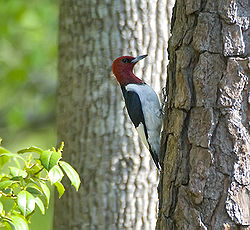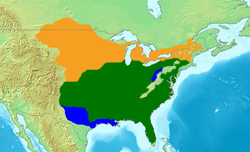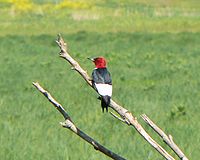- Red-headed Woodpecker
-
Not to be confused with Red-bellied Woodpecker.
Red-headed Woodpecker 
Conservation status Scientific classification Kingdom: Animalia Phylum: Chordata Class: Aves Subclass: Neornithes Infraclass: Neognathae Superorder: Neoaves Order: Piciformes Suborder: Pici Family: Picidae Subfamily: Picinae Tribe: Dendropicini Genus: Melanerpes Species: M. erythrocephalus Binomial name Melanerpes erythrocephalus
(Linnaeus, 1758)
Red-headed Woodpecker range. Orange indicates summer range; green indicates year-long residency; blue indicates wintering range. The Red-headed Woodpecker, Melanerpes erythrocephalus, is a small or medium-sized woodpecker from temperate North America. Their breeding habitat is open country across southern Canada and the eastern-central United States.
Contents
Taxonomy
The Red-headed Woodpecker was one of the many species originally described by Linnaeus in his 18th-century work Systema Naturae.[1] The specific epithet is derived from the Ancient Greek words erythros 'red' and kephalos 'head'.[2]
There are three subspecies recognized:
- M. e. brodkorbi
- M. e. caurinus
- M. e. erythrocephalus
Description
Adults are strikingly tri-colored, with a black back and tail and a red head and neck. Their underparts are mainly white. The wings are black with white secondary remiges. Adult males and females are identical in plumage.[3] Juveniles are similarly shaded, but are mottled with brown.[3] Non-birders may often mistakenly identify Red-bellied Woodpeckers as Red-headeds, whose range overlaps somewhat with that of the Red-headed woodpecker. While red-bellied woodpeckers have some bright red on the backs of their necks and heads, red-headed woodpeckers have a much deeper red that covers their entire heads and necks, as well as a different overall plumage pattern.
Both sexes are from 7.5-9.1 inches (19-23 cm) in length, with a wingspan of 16.5 inches (42 cm). They weigh 2.0 to 3.2 ounces (56-91 g).
They give a tchur-tchur call or drum on territory.
Behavior
These birds fly to catch insects in the air or on the ground, forage on trees or gather and store nuts. They are omnivorous, eating insects, seeds, fruits, berries, nuts, and occasionally even the eggs of other birds.[3] About two thirds of their diet is made up of plants.[3] They nest in a cavity in a dead tree, utility pole, or a dead part of a tree that is between 8 and 80 feet (2.5 to 25 m) above the ground.[3] They lay four to seven eggs in early May which are incubated for two weeks.[3] Two broods can be raised in a single nesting season.[3] Northern birds migrate to the southern parts of the range, with most having arrived on the breeding range by late April, and having left for winter quarters by late October;[4] southern birds are often permanent residents.
Conservation
Once abundant, populations have seriously declined since 1966 due to increased nest site competition from European Starlings and removal of dead trees (used as nesting sites) from woodlands. Many Northeastern states no longer have nesting red-headed woodpeckers. In Ohio, for example, an irregular population is present in most years, but it is not self-sustaining.[5]
The red-headed woodpecker is listed as a vulnerable species in Canada and as a threatened species in some states in the US. The species has declined in numbers due to habitat loss caused by harvesting of snags, agricultural development, channeling of rivers, a decline in farming resulting to regeneration of eastern forests, monoculture crops, the loss of small orchards, and treatment of telephone poles with creosote.[6]
Of the 600 Canadian Important Bird Areas only seven report the Red-headed Woodpecker in their area: Cabot Head, Ontario on the Georgian Bay side of the tip of Bruce Peninsula; Carden Plain, Ontario east of Lake Simcoe; Long Point Peninsula and Marshes, Ontario along Lake Eire near London, Ontario; Point Abino, Ontario on Lake Erie near Niagara Falls; Port Franks Forested Dunes, Ontario northeast of Sarnia on Lake Huron; Kinosota/Leifur, Manitoba at the northwest side of Lake Manitoba south of the Narrows and east of Riding Mountain National Park; and along South Saskatchewan River from Empress, Alberta to Lancer Ferry in Saskatchewan. [7]
Popular culture
In 1996, the United States Postal Service issued a 2-cent postage stamp depicting a perched red-headed woodpecker.[8] The stamp was discontinued at some time thereafter, but re-issued in 1999 and remained available for purchase until 2006.[9]
Footnotes
- ^ (Latin) Linnaeus, C (1758). Systema naturae per regna tria naturae, secundum classes, ordines, genera, species, cum characteribus, differentiis, synonymis, locis. Tomus I. Editio decima, reformata.. Holmiae. (Laurentii Salvii)..
- ^ Liddell, Henry George and Robert Scott (1980). A Greek-English Lexicon (Abridged Edition). United Kingdom: Oxford University Press. ISBN 0-19-910207-4.
- ^ a b c d e f g Porter, Eloise F.; James F. Parnell, Robert P. Teulings, Ricky Davis (2006). Birds of the Carolinas Second Edition. Chapel Hill, NC: University of North Carolina Press. pp. 220. ISBN 978-0-8078-5671-0.
- ^ Henninger (1906), OOS (2004)
- ^ OOS (2004)
- ^ BirdHouses101.com (2007)
- ^ Important Bird Area Canada, Site Catalogue Query
- ^ ASP (1996)
- ^ USA Philatelic (2006)
References
- America's 1996 Stamps Program (1996): Red-headed Woodpecker. Retrieved 2006-JAN-31.
- BirdHouses101.com (2007): Red-headed Woodpecker. Version of 2007-SEP-30. Retrieved 2008-FEB-14.
- BirdLife International (2004). Melanerpes erythrocephalus. 2006. IUCN Red List of Threatened Species. IUCN 2006. www.iucnredlist.org. Retrieved on 9 May 2006. Database entry includes a brief justification of why this species is near threatened
- Henninger, W.F. (1906): A preliminary list of the birds of Seneca County, Ohio. Wilson Bull. 18(2): 47-60. DjVu fulltext PDF fulltext
- Ohio Ornithological Society (OOS) (2004): Annotated Ohio state checklist. Version of April 2004. PDF fulltext
- USA Philatelic (2006): Red-headed Woodpecker. USA Philatelic 11(1): 31.
External links
- - USGS - Red-headed Woodpecker
- The Nature Conservancy's Species Profile: Red-headed Woodpecker
- - Cornell Lab of Ornithology - Red-headed Woodpecker
- - Red-headed Woodpecker Recovery
- - Enature.com - Red-headed Woodpecker
- - South Dakota Birds - Red-headed Woodpecker
- A video to see and hear the Red Headed Woodpecker
Categories:- IUCN Red List near threatened species
- Woodpeckers
- Melanerpes
- Birds of the United States
- Birds of Canada
- Eastern North American migratory birds
Wikimedia Foundation. 2010.


